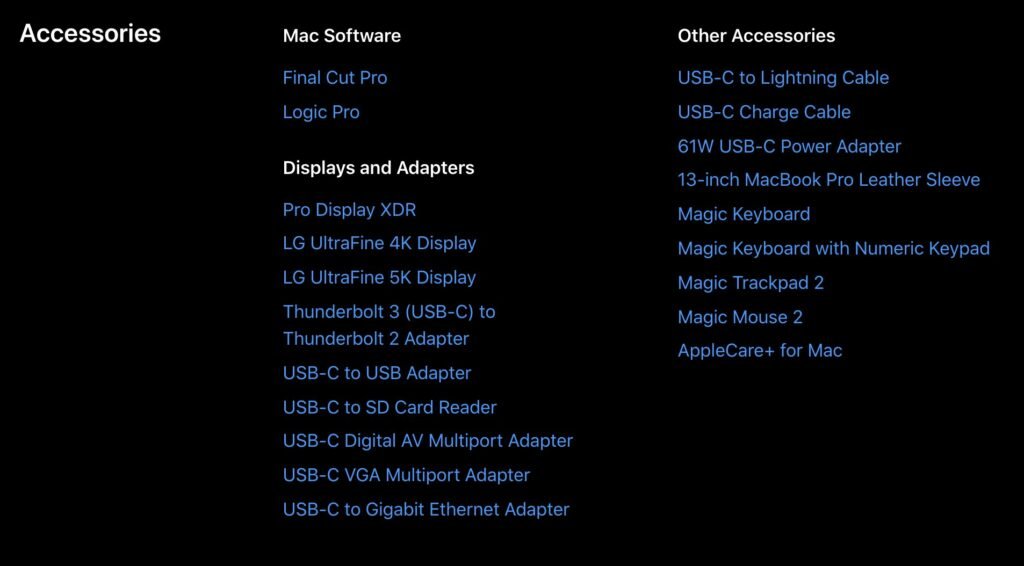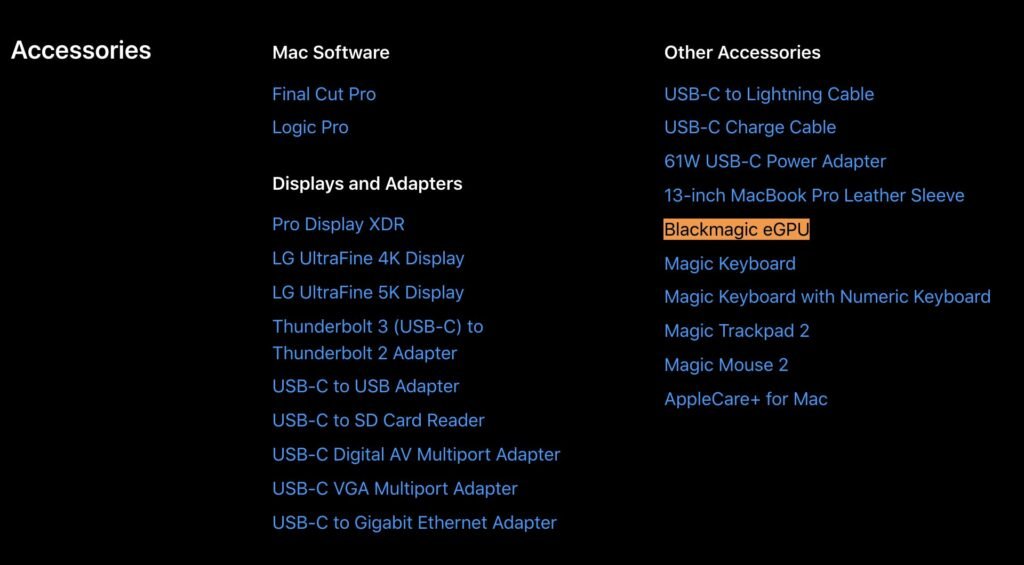Well, today Apple pulled the wraps off their new toys in a manner that surprised almost nobody at all. We got new portables and a new Mac mini (which hadn’t been talked about a great deal by anyone, but seemed a shoo-in on the grounds that the Apple Silicon Dev kit was… also a Mac mini). And these are all great products, and will do very well because they’ll do what they do very well.
What they won’t do very well? Not much, but I can think of one glaring problem if you’re anyone who works in design, video or do a lot of CAD work – and it’s not really Apple’s fault. What’s the problem? I’ll give you a hint in the form of the accessories available for the new MacBook Pro:

Too oblique? Okay, that’s understandable – if you’re looking at a forest and don’t notice that it’s missing a tree, then that’s not on you. Here, I’ll make it easier by showing you the accessories available for the older, Intel-based MacBook Pro:

Now I am – and this is no surprise to anyone who knows me – not what you’d call a world-expert on chip design, but it’s pretty clear to me that in putting the entire system (CPU, Cache, Neural Engine, Fabric, GPU and DRAM) on a single chip then you’re somewhat boxed into the idea that you’re stuck with integrated graphics. And if that’s the case, then said system on a chip is – by its nature – not going to have any mechanism to go and talk to discreet graphics – whether it’s a graphics card or an eGPU. It’s counter to the design of the thing.
Still, no eGPU support isn’t entirely surprising when you consider the nature of the beast(s). These are, after all, not Pro machines. Yes, yes, I know: the MacBook Pro has “Pro” in the name and is used by professionals, but the 13-inch model isn’t historically renowned as the hard-hitting graphical powerhouse of the line. And, to be fair, the M1’s octo-core GPU generates some very decent numbers – from peering uneasily at screen grabs and doing some back-of-the-napkin math it looks like the thing’ll churn out about half of a Radeon RX 580, which while admittedly a long way from the top of the heap isn’t exactly chump change, either.
I don’t mean to dump on these new machines. They’re really, really great products (and I’ve already ordered a couple of Airs for my kids). As a first run, it’s extremely impressive that Apple’s managed to come up with machines that are bound to make Intel go a little pale and wobbly-footed, but it’s also true that having machines this powerful at the low end of the range generates some interesting questions about the rest of the product line. Benchmarks have yet to be forthcoming, but based on the claims of speed increases from the older, intel-based versions of the MacBook Air, MacBook Pro and Mac mini it rather looks like those computers will cheerfully stomp all over the iMac and iMac Pro in raw performance, and even give the Mac Pro a bit of a turn.
Except when it comes to tasks and pro use-cases that involve significant GPU compute needs, that is, which raises two questions (both of which I have actually been asked this morning):
Are the rest of Apple’s desktop products suddenly lame ducks?
If you’re, say, the manager of a small publishing company with a limited budget, what reason is there to go and buy four new iMacs? After all, there are going to be new, M1-based iMacs coming out at some point.
Are Apple’s Pro computers ever going to be good again?
Further from the last question – is it even possible that Apple can make a chip that can compete with some of the higher-end graphics cards? After all, those are companies that have years of experience and deep benches of R&D expertise, and even assuming that it’s possible to compete, why would you want to buy a pro machine with non-upgradeable graphics cards?
I won’t lie; this was an awkward conversation. But I’ll put down what I said after a couple of minutes of thought. Maybe – just maybe – we’re thinking about what a Pro machine is, and coming up with some answers that are informed by what we’ve been conditioned to believe instead of thinking flexibly. Maybe we’re looking at it all wrong.
Graphics cards are awful devices. No, really; finicky, phenomenally expensive, prone to failure and oft laid low by software problems (not to mention hot and noisy and wildly, wildly power-hungry). One of the rumors about the new Mac line has been about a supposed new Mac Pro – much smaller – and the feedback I’ve read has solidly fallen into discussions about how there’ll be no room for expandability, adding extra cards and storage and so forth. Maybe we’re looking at this kind of problem the same way that people looked at the first cars and sniffed, derisively, pointing out that there was no place to attach the horses to the front of the thing.
I don’t think we’re going to see Macs (and by association, a lot of the PC market) using discreet graphics in future. Yes, there are people who upgrade their pro machines with new-and-improved hardware as time goes by, but I’ve worked with those clients for the thick end of two decades and the vast, vast majority of those clients? When they’re ready for an upgraded graphic card, they look at the budget, look at the depreciation scheduled, and just buy a new computer.
There’s a reason that Apple rolled out Apple Silicon the way that it has. Consumer/Prosumer machines first (because the M1’s secret weapon is it’s absurdly low power footprint); and then, later on, a followup product with significantly more graphic cores. After all, if a Mac mini with eight GPU Cores can come within punching distance of a decent graphics card, what can a twelve core card do? Or a sixteen core? Or a thirty-two core?
My money says that we’ll see an Apple Silicon iMac within the year, with graphical performance that’ll jump up and down all over the current iMac range. In the mean time, though, I think there’ll be a lot of difficult decisions to make about sticking with Intel-based Macs…
